Creating a Radha Krishna drawing is a beautiful journey into the realms of devotion and artistic expression. The process begins with a deep understanding of the divine love shared between Lord Krishna, the playful and enchanting deity, and Radha, the embodiment of pure devotion. Artists embark on this sacred endeavor by sketching the outlines of these divine figures, carefully capturing the intricacies
- Exploring the Artistry of Radha Krishna Drawings
- A Step-by-Step Guide to Radha Krishna Drawing
- The Spiritual Essence of Radha Krishna Artwork
- Capturing the Joy in Radha Krishna Sketches
- Conveying Serenity through Radha Krishna Art
- Incorporating Symbolism in Drawings
- A Palette Guide for Radha Krishna Artistry
- Frequently Asked Questions (FAQs)
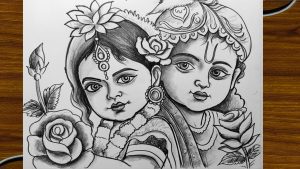
Exploring the Artistry of Radha Krishna Drawings
Delving into the artistry of Radha Krishna drawings is like stepping into a vibrant tapestry of devotion, love, and divine beauty. These captivating depictions capture the essence of the divine couple, Radha and Krishna, whose celestial connection has inspired artists for centuries. Let’s explore the magic behind these fascinating creations:
1. Styles and Traditions:
- Traditional Indian styles: Miniature paintings from Rajasthan, Pichhwai paintings from Nathdwara, and Pattachitra from Odisha are renowned for their intricate details, vivid colors, and symbolic representations of Radha and Krishna.
- Folk art: Madhubani paintings from Bihar and Warli art from Maharashtra offer a simpler, yet charming, portrayal of the divine couple, using bold lines, geometric patterns, and earthy tones.
- Contemporary reinterpretations: Modern artists are reinterpreting Radha Krishna drawings through various styles, from photorealistic renditions to abstract expressions and minimalist sketches, injecting a fresh perspective into the tradition.
2. Capturing the Divine Essence:
- Symbols and motifs: Lotus flowers symbolize divine love and purity, peacocks represent beauty and grace, and flutes evoke Krishna’s playful persona. Artists meticulously incorporate these elements to enhance the meaning and symbolism of the drawings.
- Expression and emotion: The subtle nuances in Radha and Krishna’s eyes, the tilt of their heads, and the way they intertwine their hands all speak volumes about their deep connection and the tender emotions they share.
3. Beyond the Drawing:
- Storytelling: Many Radha Krishna drawings narrate specific episodes from their mythological tales, like the Ras Leela, their playful dance in the moonlight, or the Gopis’ yearning for Krishna. The drawings become windows into these captivating stories.
- Devotional purpose: Often used in temples and personal altars, Radha Krishna drawings serve as objects of devotion, fostering connection with the divine couple and offering solace and inspiration.
- Cultural expression: These drawings reflect the values, beliefs, and artistic traditions of the communities that create them, offering a glimpse into their unique cultural landscape.
Exploring Radha Krishna drawings is not just about appreciating artistry; it’s about delving into a world of devotion, mythology, and cultural expression. Whether you’re an art enthusiast, a spiritual seeker, or simply fascinated by the divine love story of Radha and Krishna, these captivating creations offer a rich tapestry to explore and connect with.
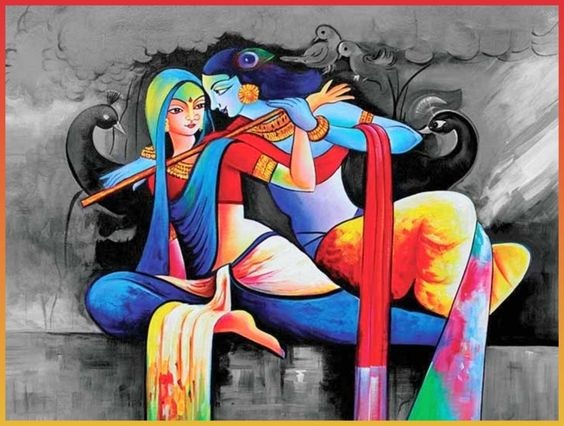
A Step-by-Step Guide to Radha Krishna Drawing
Bringing the divine couple, Radha Krishna Drawing, to life on paper can be a truly rewarding experience. Here’s a step-by-step guide to get you started:
1. Choose your Style and Reference:
- Traditional: Immerse yourself in miniature paintings, Pichhwai, or Pattachitra styles for rich details and symbolism. Reference specific artworks you admire.
- Contemporary: Choose a modern artist whose interpretation resonates with you and use their work as a guide.
- Simple Sketch: Focus on capturing the essence through expressive lines and minimal details.
2. Sketch the Composition:
- Proportions: Use basic shapes like circles and ovals to block in the heads, torsos, and limbs, ensuring proportionate figures.
- Pose and Gesture: Decide on the posture and interaction between Radha and Krishna. Will they stand facing each other, playing music, or lost in conversation?
- Compositional Balance: Distribute figures and background elements to create a harmonious and visually pleasing arrangement.
3. Refine the Features:
- Facial Expressions: Pay close attention to the eyes, eyebrows, and lips to convey emotions like love, joy, or tenderness.
- Hands and Feet: These elements add detail and gesture. Refer to traditional iconography for hand positions holding instruments or symbolic gestures.
- Drapery and Clothing: Use flowing lines and subtle folds to depict their garments, adding elegance and movement.
4. Define Details and Ornamentation:
- Jewelry and ornaments: Traditional styles often feature elaborate crowns, earrings, and anklets. Add these carefully, balancing detail without overwhelming the composition.
- Background: Depending on your chosen style, you can keep it simple with a flat color or add elements like a lush forest, celestial motifs, or symbolic architecture.
- Symbolism: Consider incorporating symbolic elements like lotus flowers, peacocks, or flutes to enhance the narrative and meaning of your drawing.
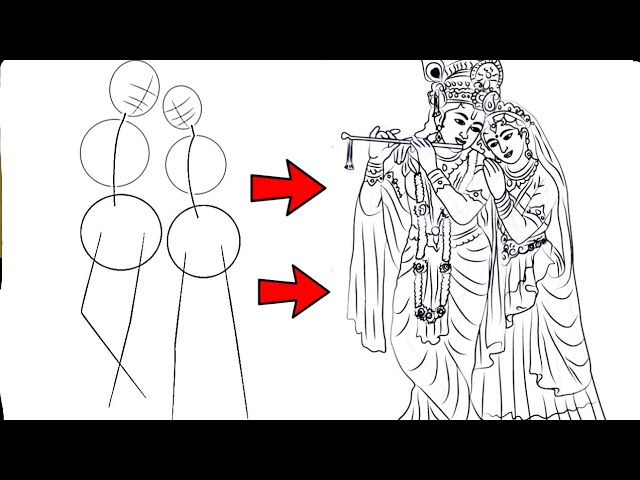
The Spiritual Essence of Radha Krishna Artwork
Radha Krishna Drawing transcends mere aesthetics; it delves into the realm of the spiritual, resonating with devotees and art enthusiasts alike. Here’s a deeper exploration of the spiritual essence woven into these captivating creations:
1. Divine Connection:
- Symbolism of Love: Radha and Krishna’s intertwined figures, their loving gazes, and the dance of their hands metaphorically represent the ultimate, divine love, transcending earthly limitations.
- Path to Devotion: The artwork acts as a bridge between the viewer and the divine couple, inspiring contemplation, prayer, and a yearning for spiritual connection.
- Expression of Mythology: Through depictions of their playful Ras Leela or tender moments, the artwork narrates their celestial stories, reminding us of their divine love and playful nature.
2. Visual Mantras:
- Mandalas and Geometry: In certain styles like Pattachitra, intricate mandala patterns and geometric forms hold symbolic meaning, representing the cosmos, divine energy, and spiritual balance.
- Colors and Pigments: Traditional colors like vibrant reds, blues, and yellows have specific connotations – red symbolizing passion and devotion, blue representing calmness and divinity, and yellow signifying radiance and enlightenment.
3. Cultural Tapestry:
- Devotional Expression: For countless communities, Radha Krishna artwork adorns temples, altars, and homes, serving as a tangible expression of devotion and a daily reminder of their divine presence.
- Storytelling and Values: These drawings, passed down through generations, narrate mythological tales, reinforcing cultural values like love, devotion, and spiritual connection.
- Community and Connection: Creating and appreciating Radha Krishna artwork becomes a shared experience, fostering a sense of community and collective connection to the divine couple.
Beyond mere artistic beauty, Radha Krishna artwork evokes deep spiritual emotions, inspires devotion, and serves as a window into the celestial love story that continues to captivate hearts and minds. It’s a visual language that transcends words, speaking to the soul and offering a pathway to spiritual connection.
Here are some ways to further explore the spiritual essence of Radha Krishna artwork:
- Visit temples and cultural centers: Immerse yourself in the aura of devotion and observe how artwork is used in religious practices.
- Learn about symbolism and iconography: Delve deeper into the meaning behind colors, postures, and specific elements used in the drawings.
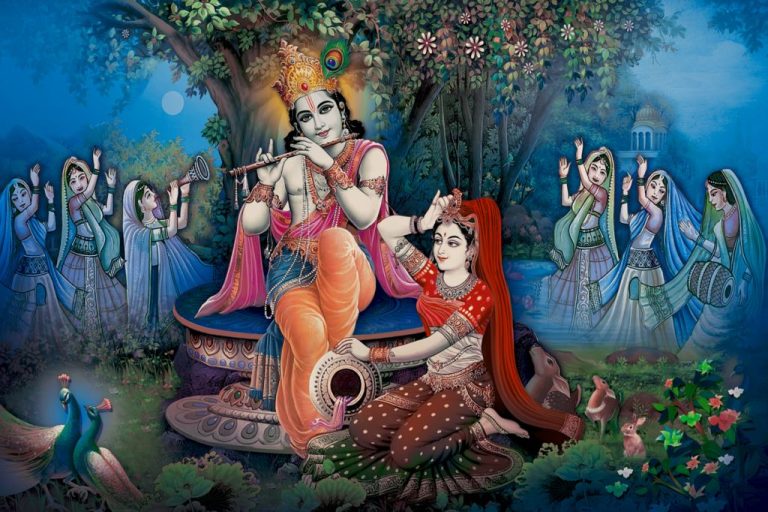
Capturing the Joy in Radha Krishna Sketches
capturing the joy in Radha Krishna sketches – what a beautiful and vibrant challenge! It’s about translating their playful dance of love, their shared laughter, and the sheer delight they find in each other’s presence into lines and forms on paper. Here are some tips to help you bring their joyous essence to life:
1. Through Movement and Gesture:
- Dancing figures: Let their bodies flow in rhythmic harmony, limbs intertwining, hands outstretched in playful abandon. Use fluid lines and dynamic postures to convey the energy of their dance.
- Expressive gestures: Emphasize their playful interactions. Radha throwing her head back in laughter, Krishna teasingly pulling a braid, their hands holding and intertwining – tell a story through their body language.
- Eyes twinkling with delight: Pay close attention to their eyes. Let them sparkle with mischief, twinkle with love, and radiate the inner spark of their shared joy.
2. Lightness of Being:
- Flowing lines and graceful forms: Avoid heavy lines and harsh angles. Opt for light, flowing strokes that suggest movement and airiness, reflecting their carefree spirit.
- Negative space as playground: Utilize negative space to create a sense of openness and freedom. Let their figures move in and out of empty spaces, emphasizing their playful interaction with the environment.
3. Palette of Vibrant Colors:
- Burst of colors: Opt for a vibrant palette that reflects the joyous energy of their love. Think warm yellows, playful oranges, and splashes of pinks and greens.
- Color gradients and playful transitions: Don’t shy away from blending and layering colors. Create soft transitions, subtle highlights, and unexpected splashes of color to mimic the vibrancy of their love.
- Symbolic hues: Consider incorporating colors with specific meanings in the Hindu tradition. Red for passion, yellow for enlightenment, and blue for calmness can add deeper layers to your artistic expression.
4. Beyond Technique, Capture the Essence:
- Inhale their laughter, exhale it onto the paper: Close your eyes and imagine their playful banter, their shared laughter. Let that feeling guide your hand as you sketch, translating the emotional energy into lines and forms.
- Remember the music: Their love is often associated with music and dance. Let the rhythm of their melody flow through your strokes, creating a sense of movement and musicality in your artwork.
- Don’t be afraid to play: Experiment with different styles, break from traditional forms, and embrace the spontaneous spirit of their connection. Let your joy in depicting their love guide your artistic journey.
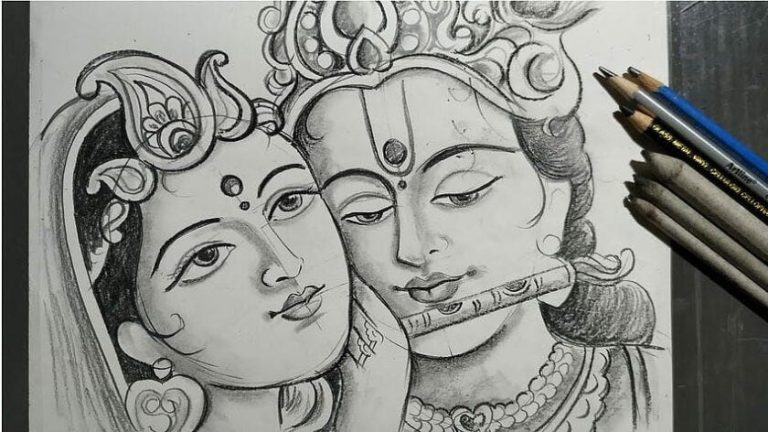
Conveying Serenity through Radha Krishna Art
Radha and Krishna, beyond their playful dance and passionate love, also embody a profound sense of serenity and divine peace. Capturing this serene essence in art requires a shift in focus, drawing the viewer into a meditative space of tranquility. Here are some ways to convey serenity through your Radha Krishna artwork:
1. Through Composition and Form:
- Balanced postures and gestures: Instead of dynamic movement, depict them seated calmly, perhaps in meditation or gazing into each other’s eyes. Use symmetrical compositions and balanced postures to create a sense of stillness and harmony.
- Soft, flowing lines: Abandon sharp angles and opt for gentle, sweeping lines that evoke calmness and tranquility. Imagine their forms merging softly with the surrounding environment, blending seamlessly into the aura of peace.
- Subtle gestures and expressions: Instead of playful interactions, focus on subtle gestures like hands gently touching, a serene smile playing on their lips, or their gazes locked in quiet understanding.
2. Colors and Light:
- Muted and harmonious palettes: Move away from the vibrant hues of their playful depictions and explore softer, more muted tones. Blues, greens, and gentle shades of yellow and lavender can evoke a sense of calmness and tranquility.
- Gradients and subtle shifts: Create soft transitions between colors, avoiding harsh contrasts. Let the colors blend seamlessly, suggesting a gentle flow of energy and inner peace.
- Diffused light and gentle shadows: Avoid harsh contrasts of light and shadow. Opt for a soft, diffused light that bathes their figures and the surrounding environment in a warm glow of serenity.
3. Symbols and Motifs:
- Lotus flowers: These symbolize purity, spiritual awakening, and inner peace. Incorporate them subtly in the background or around their figures to subtly emphasize the presence of divine serenity.
- Nature’s tranquility: Depict them amidst serene landscapes – lush meadows, tranquil forests, or the calm flow of a river. Let the natural world reflect the inner peace they share.
Incorporating Symbolism in Drawings
Incorporating symbolism in your drawings can elevate them from mere sketches to thought-provoking pieces that resonate with viewers on deeper levels. Here are some tips to weave meaningful symbolism into your art:
1. Choosing Your Symbols:
- Consider your theme: What message or feeling do you want to convey? Choose symbols that align with your overall intent.
- Personal connections: Look for symbols that hold personal meaning for you, drawing inspiration from your experiences, beliefs, or cultural background.
- Universal symbols: Explore widely recognized symbols like a dove for peace, a skull for mortality, or an hourglass for time passing.
2. Subtlety and Ambiguity:
- Don’t over-explain: Avoid being too literal or obvious. Let the symbols evoke different interpretations and spark curiosity in the viewer.
- Layered meanings: Use multiple symbols that interact and enhance each other’s meaning. This creates a richer tapestry of interpretation.
3. Integrating Symbols into your Drawing:
- Focus and composition: Place your symbols strategically within the drawing to guide the viewer’s eye and emphasize their importance.
- Scale and repetition: Vary the size and repetition of symbols to create emphasis or build a sense of rhythm and pattern.
- Style and technique: Consider how your chosen style and techniques can enhance the symbolism. For example, using a dreamlike, surreal style might amplify the metaphorical power of your symbols.
4. Inspiration and Research:
- Mythology and folklore: Explore symbols used in different cultures and historical periods to find inspiration for your own work.
- Literature and art history: Look at how established artists have incorporated symbolism in their work to learn from their techniques.
- Nature and everyday objects: Find symbolic meaning in the world around you. Birds, trees, weather patterns, or even common objects can hold symbolic potential.512
A Palette Guide for Radha Krishna Artistry
the vibrant world of Radha Krishna artistry beckons! Choosing the right palette can make all the difference in capturing the essence of their divine love and the diverse moods evoked in their stories. Here’s a guide to explore:
Traditional Splendor:
- Rich hues: Immerse yourself in the vibrant reds, deep blues, and lush greens often found in Pichhwai paintings and miniature styles. Gold leafing adds a touch of celestial radiance.
- Symbolic colors: Red symbolizes passionate love and devotion, blue represents calmness and divinity, yellow signifies enlightenment and joy. Use these colors strategically to enhance the narrative and meaning of your artwork.
- Contrasts and harmony: Balance bold contrasts with harmonious transitions and subtle blends. Think fiery reds juxtaposed with calming blues, or emerald greens blending into golden yellows.
Contemporary Interpretations:
- Muted elegance: Explore softer, pastel shades like lilac, sage green, and rose quartz for a more modern and introspective feel.
- Monochrome magic: Experiment with black and white or shades of a single color for a dramatic and impactful effect.
Mood and Theme:
- Joyful dance: Opt for a vibrant palette with warm yellows, oranges, and playful pinks to capture the energy and exuberance of their dance in the moonlight.
- Serene meditation: Choose muted blues, greens, and soft yellows to evoke tranquility and inner peace, portraying their moments of quiet contemplation.
- Mythological storytelling: Adapt your palette to the specific story you’re depicting. Fiery reds and oranges might suit Krishna’s battle scenes, while cool blues and purples could bring out Radha’s yearning in Gopis’ stories.
Remember:
- Experiment and trust your intuition! There’s no single “correct” palette. Play with different colors, observe nature, and see what resonates with you and your chosen style.
- Quality matters: Invest in good quality paints and brushes that will bring out the true vibrancy of your chosen colors.
Frequently Asked Questions (FAQs)
- Start with simple shapes: Begin by sketching basic shapes like circles, ovals, and rectangles to represent the head, torso, and limbs. This will help you build a foundation for your drawing before adding details.
- Pay attention to proportions: The proportions of a girl’s body are generally different from those of a boy. For example, the head is typically larger in proportion to the body, and the waist is narrower than the hips.
- Oversexualization: Avoid drawing girls in overtly suggestive poses or clothing. Focus on capturing their personality and individuality rather than their physical attributes.
- Clichés and stereotypes: Don’t fall into clichés like damsels in distress or overly bubbly princesses. Be creative and explore diverse representations of girls.
- Art books and tutorials: There are many great books and online tutorials available that can teach you how to draw girls in different styles. Look for resources specifically focused on female figure drawing or character design.
- Online communities: Join online communities or forums for artists who draw girls. This is a great way to get feedback on your work, learn from others, and stay inspired.
Related posts:
- Cute Girl Drawing : Tips for Creating Cute Girl
- Girl Drawing Easy : Benefits of Girl Drawing
- Landscape Drawing
- Oil Pastel Drawing : Mastering the Art of Oil Pastel
- Santa Claus Drawing : Tips for Drawing
- Save Water Drawing : How Art Inspires a Water-Wise Future
- Simple Drawings : Finding Beauty in Basic Lines
- Christmas Tree Drawing




















